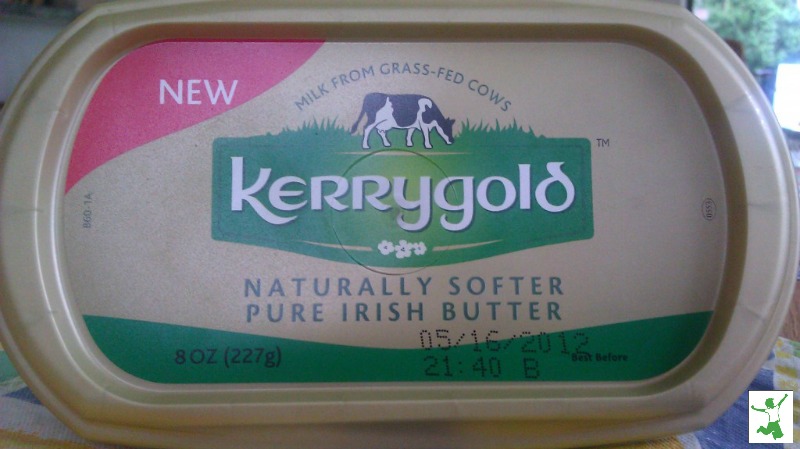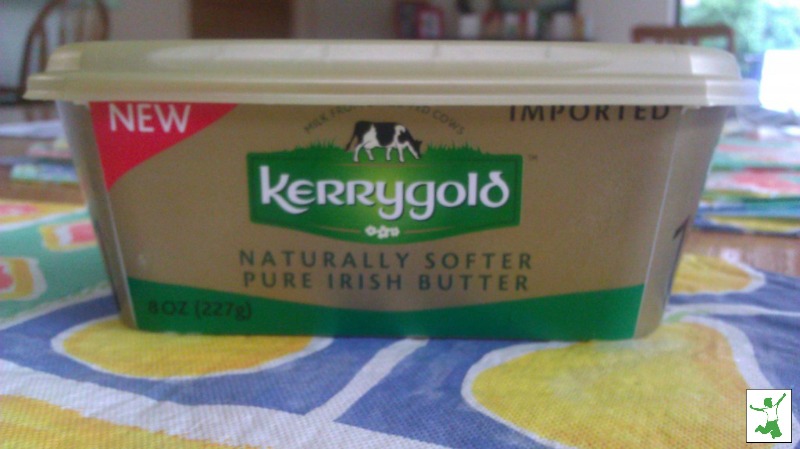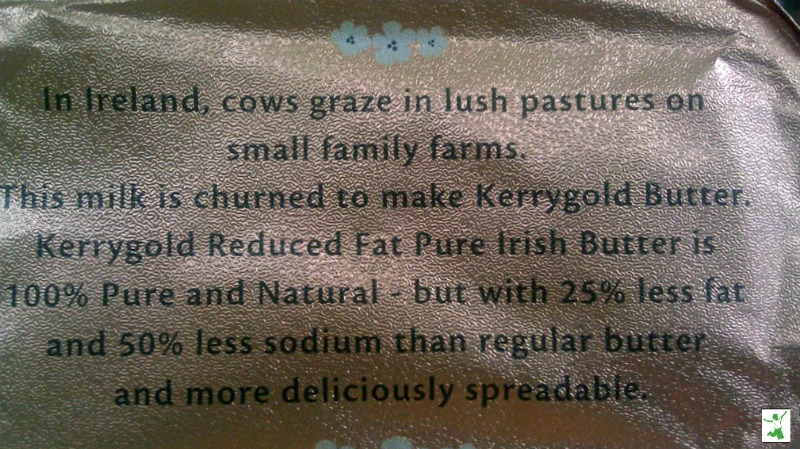Table of Contents[Hide][Show]
Kerrygold is marketed as grass-fed and all-natural, but the tub butter has concerning ingredients, dangers and marketing ploys to consider before buying.

Kerrygold, without question, is probably one of the best store butters you can buy. I myself have been using it for years for cooking.
The milk is from grass-fed cows and even though the cream used to make Kerrygold Butter is pasteurized, it is the best choice available to most folks who do not have access to raw butter from a small farm or who simply don’t want to use their precious raw butter for cooking.
I also know that many of you out there use Kerrygold too. When I conducted a Butter Poll on this blog awhile back, by far the most used butter (out of 1,500 or so total votes) was Kerrygold which received way more votes than even Organic Valley butter.
So what’s the problem?
My husband brought home the “new” Kerrygold butter the other day. On the surface, it looked fine. Nowhere on the outside of the package was there any indication that there was a problem with this butter. Here’s what it looks like.

I got suspicious with the “new” label, however. There’s nothing “new” about butter. That’s what I like about it after all!
Another tip-off that there was a problem lurking was the proclamation on the label that this “New Kerrygold” was “naturally softer”.
When I first saw the “naturally softer” words, I thought that meant that the butter was whipped and hence more spreadable. I don’t know about you, but I don’t want air whipped into my butter. This is a surefire way to get less product and get charged the same price for the privilege if you know what I mean.
I made a mental note to tell my husband not to buy this butter again because it was whipped and not as good a value.
But then, it got way worse…
Is Kerrygold Butter Grass-fed?
I took off the lid to the new Kerrygold package and saw the following words:

I had become a victim of the Big Fast One!
Kerrygold is stealthily selling LOWFAT butter and guess what? You get to pay the same price for the cheaper quality!
NOWHERE on the outside of the label did it say that the butter was low-fat. The ingredients said simply: pasteurized cream and salt the same as the commercialized Amish butter at the supermarket.
I daresay that this marketing ploy will be fooling a lot of folks who desire to buy full-fat grass-fed butter.
It seems that some butter brands have adopted what companies making substitutes for butter have been doing for years.
I have become very tuned in to these labeling tricks and manufacturer games over the years. When it comes to packaging, I double-check the ingredients along with the manufacturing processes every few months. This is even for products that I’ve been buying for years.
But how many people really do this?
Ingredient Bait and Switch
You NEED to be doing this!
Manufacturers are changing ingredients and packaging all the time! The primary intent of these “improvements” is to increase product sales and profitability. Your health is, sadly, of little to no concern in the grand scheme of things.
Reducing the fat content in its butter will skyrocket profits for Kerrygold as they will make the same per unit for the butter and yet be able to sell the skimmed cream to other companies to make ice cream or whatnot thereby increasing revenue substantially.
If you buy Kerrygold, I’m not telling you to stop buying it. I’m only telling you to beware of this new packaging nonsense and be sure what you buy is what you intend: full-fat butter!
By the way, if you are wondering why I love full-fat butter, you might want to educate yourself on the low-fat scam by learning about the history of butter vs margarine in the United States.
As for me, I will be returning this product to the store for a full refund. It is falsely advertised after all. I had no way of knowing it was a low-fat product until I opened it.
Manufacturer Response
I received this email from Kerrygold following the widespread sharing of this article. I find it very hard to believe that my blog suddenly brought this packaging error to their attention.
Do they have NO ONE on the production line in charge of quality control? This was not a difficult problem to identify. Could we have a bit of spin going on here? Perhaps so.
Dear Sarah,
Your blog has brought to our attention a packaging error of which we were unaware. While Kerrygold does sell a Reduced Fat & Sodium Butter the pack you show on your blog is 100% full fat butter which has been packed with the incorrect inner seal. There is no deliberate intent on our part to mislead our valued consumers or to misrepresent our product although we regret the confusion this is clearly creating.
We are working to identify how much product has been released into the market with the incorrect packaging so that we can replace it as soon as possible. In the meantime we would appreciate your assistance in clarifying the misunderstanding to your readers. We would love to provide further clarity — our email is [email protected] — and we are happy to answer any specific questions you and your readers may have in relation to the product.
With thanks & regards,
The Kerrygold Team
Why I No Longer Buy Kerrygold
I wanted to let all of you know that I no longer buy even the traditional Kerrygold brick butter in foil packaging. Why? A good friend visited Ireland and traveled extensively to a number of grass-based dairy farms.
This credible source told me that while the cows that provide cream for the Kerrygold butter are definitely on pasture and hence “grass-fed”, they receive supplemental GMO animal feed as well especially during the winter months. The local community and citizenry in Ireland concur and will tell you as much if you are in the area.
So, the word on the street is that Kerrygold is not legitimately pastured either.
Butter from cows that get GMO feed introduces the very real possibility of Roundup residue in the butter.
Thanks but no thanks!
While I have not been able to confirm this story 100%, I trusted the credibility of the information enough to permanently switch to another brand (I currently use this one).
I use this butter for cooking in addition to the homemade pastured raw butter I make for non-cooking purposes.
I also no longer recommend Kerry Gold in my Shopping Guide.
What about Organic Valley butter as an alternative to Kerry Gold? While I am not happy about Organic Valley’s policy that disallows member farmers to sell raw milk on the side to their community (treating them more like medieval serfs than the independent business owners that they are), I find this less onerous than deceptively feeding animals GMO feed without clearly informing the end consumer.









I’m not surprised that KerryGold contacted you — any blog that can generate 185 comments in a day isn’t one to ignore. Good for you! And thank you for the heads up. It’s so exhausting (as Allison said in a prior comment) to have to check every label, every time, but that’s the only way to be sure.
I suppose we are lucky that labeling laws are as strong as they are — it wasn’t always so. Imagine if there was no law against, say, selling trans-fat labeled as “100% pure butter”?
What’s interesting is that I’ve contacted them about how they make this reduced fat butter and have heard nothing back .. they obviously DON”T want me to blog about it! LOL
Mmmmm are we perhaps hiding something?
I’m grateful that Sarah wrote this post and that Kerrygold responded. I pay a lot of money for Kerrygold butter and I want to get exactly what a pay good money for. Sarah has been telling readers for as long as she’d had this blog to buy Kerrygold butter. She cannot to continue to recommend a product she doesn’t trust. I will still buy Kerrygold butter but only the bricks. It’s very hard to trust food companies these days…
sarah,
have you noticed a change in the regular butter foil bricks’ yellow color? i have been buying regular foil wrapped Kerrygold butter, and the last few months I’ve noticed the yellow color is less, and more of a creamy color- inticating less vitamins.? i even started trying to calculate when spring & summer is in Ireland so I could buy their butter only during the lush green grass seasons…..but i see they claim using only summer cream for their products. so why the paler yellow color? just wondered if anyone else has noticed the difference in color too:)
I’ve had more than one person email me and say that even the full fat tub butter tastes funny and isn’t as yellow.
There is definitely something fishy going on here. A grab for more profits at the expense of product quality no doubt. I would suggest checking into the other brands of grassfed store butter that have been identified in the comments here such as Double Devon Cream Butter. I am going to investigate these as well.
I would love to hear what you find. I do think it’s as yellow and tastes the same, but it IS soft, and that is odd. It’s always been hard.
Plus, it’s cheaper (??). Was $2.99, now it’s $2.39.
Wow, thanks for the alert! I have one or two of these in the fridge, I’ll check them right now. Still, it does seem to be a possibly innocent mistake (their selling a lowfat butter product is shameful though!). Glitches get through when no one checks.
Why is it shameful for them to sell a lower fat butter? That’s apparently what some people want. I was shocked when the U.S. Dairy Coop Land-O-Lakes introduced their soft spreadable butter with canola oil – it appears to be about a 60/40 blend. But it is not bad – better than the typical vegetable oil “spreads” and I buy it sometimes when on sale and I also have a coupon. I generally buy/use salted stick butter – leave it out of refrigeration on the counter. If you use it up within a week or so nothing bad happens.
Honestly, where I live its very difficult to find much of any good dairy products so I usually stick to Horizon or Naturally Preferred. Just check the label more carefully next time.
For me to buy butter is a tub in the first place would be a stretch. I would automatically think something is amiss, since butter isn’t “spreadable” unless it has been softened. To me, butter in the tub is just plain wrong. When I make my butter, I put it in dishes, but then it’s kept on the counter so I can spread it when I need to use it. We eat it so fast that I never worry about it going bad. So regardless of whether they messed with the lable, I wouldn’t have bought it in the first place. I would have been highly suspicious. I will stick to the sticks!
I live in Europe and I love the Kerrygold butter (I always buy the foil-wrapped though) but I find that the Double Devon Cream Butter is of much better quality than Kerrygold.
I believe that it is also imported in the US, check it out, you’ not be disappointed!
http://www.amazon.com/Double-Devon-Cream-Butter-igourmet-com/dp/B0000TUBHS
Sarah,
First off I would like to note that at WAPF recommendation I take copious amounts of Green Pastures CLO and Butter Oil, and also consume store-bought grassfed ghee and home grown chicken eggs, on a daily basis, as well as salmon roe (on occasion, from wild salmon I caught myself 🙂 So I am not reliant on butter for my vitamins and nutrients, I just like having it in my life for even MORE vitamins and nutrients, and because we all know that butter just makes things better! 🙂 That being said, I live in a part of the country where it is quite an obstacle to get access to locally produced grass-fed milk, cream, and butter (we are under snow for the majority of the year), and because I don’t live in the continental US I pay dearly to have things shipped to me, which is not a very good use of my resources. Luckily my grocery store does carry Kerrygold. Would you suggest I stop buying Kerrygold and go back to the pale colored organic or CAFO brands, or even stop consuming butter at all? So what if Kerrygold does make full fat AND reduced fat butters, how does that change the fact that their butter is still the best in nutrients compared to their pale colored counterparts? At all your urging, along with many other model real foodies, many of us are still doing the best we can to find the highest quality butter we can get our hands on, and for me it is either pale store brand butter, pale organic butter, or yellow Kerrygold butter, and by your very own informative posts, we all know which would be the most nutritious of those three. Would you please remind readers that if Kerrygold is the most superior butter they can get their hands on, not to ditch it just because of a packaging mishap?
Thank you for your insightful blog,
Casey
Hi Casey,
Sarah didn’t say to stop buying Kerrygold if they still are selling the traditional sticks of butter. What she stated was that if they will eventually no longer sell the sticks and would just sell the tubs, then she recommends avoiding Kerrygold’s butter altogether.
Erika,
I appologize for not being quite clear before, to clear up, my store no longer carries the bricks.
Now, I realise that Sarah didn’t say to stop buying Kerrygold, but she has led many to believe that even the full fat tubs are bad, not just the low fat ones. If this is the only butter a body can get (like now in my case) then it is still better than regular butter, especially because there is no evidence that it contains any other ingredients or fat amounts from the bricks. If there is REAL evidence found and not just a wrong inner seal, I will stop buying their butter, but for now its the most nutritious kind I can get, and if other people are in the same boat then they should be encouraged in this, not guided in the other direction.
I’m not so sure the full fat tubs are ok. I’ve had several folks email me saying they weren’t as yellow as the brick butter and that the butter tasted bad. I would stick with the brick butter and if you can’t get that, switch brands such as the several suggested here in the comments that folks have posted about.
Are you Alaskan?
Hi Sarah, I used to run the QA department for a family owned dairy processing plant and I wanted to let you know that it is highly unlikely they are spinning. I really wouldn’t call it a huge error either since it was the inner foil. Now if they had put the regular butter in the light container or vice versa, that would be a major labeling and legal recall issue. You must have the product that is labeled. I can recall a time where I caught the wrong fluid milk being put in a 1% container. Fortunately it was still filling and I was able to stop the batch, but we still had to pull it all out of our cooler and reprocess. It was a simple matter of operator error in hooking up to the wrong holding tank and that’s why the QA department is there, to catch mistakes like that. But the foil mistake is certainly not intentional mislabeling. There are a few ways that I can think of where that kind of mistake might occur. There might have been extra foils from a previous batch fill put back in the wrong box before batching the regular butter. If someone grabbed a stack looking at only one label, they might not realize there were incorrect foils being applied if only a handful got out. Those machines fill, foil and seal at a high rate of speed. I would say the greater portion of quality control goes toward the actual product, but there are standard control points that should handle labeling and container issues. The cases where something gets out are rare, but they do happen and the companies that have all that precise coding are able to pinpoint not only portions of batches, but where they were distributed in order to facilitate any necessary recalls. You just hit the jackpot in being the first person to notice and comment about it. I’m not trying to minimize the mistake, just point out that these things do happen.
Thank you for pointing this out. I too agree that human error is not unlikely in cases where humans operate the machinery that labels packaging etc. My relatives own manufacturing businesses, and I have seen human/operator error happen and they have to throw out the whole batch and start over.
I am not terribly comfortable with the idea of cooked dairy, with the exception of ghee.
Ciao, Pavil
Ha, ha! Do you realize how un-mainstream that just sounded? I love it! 😀